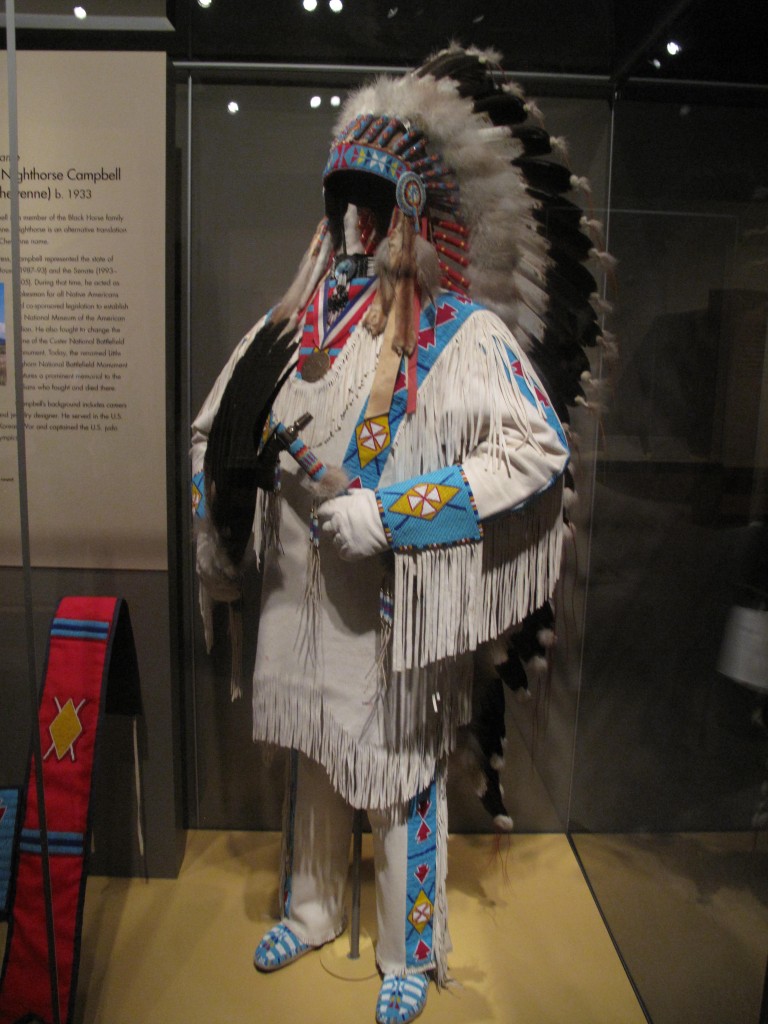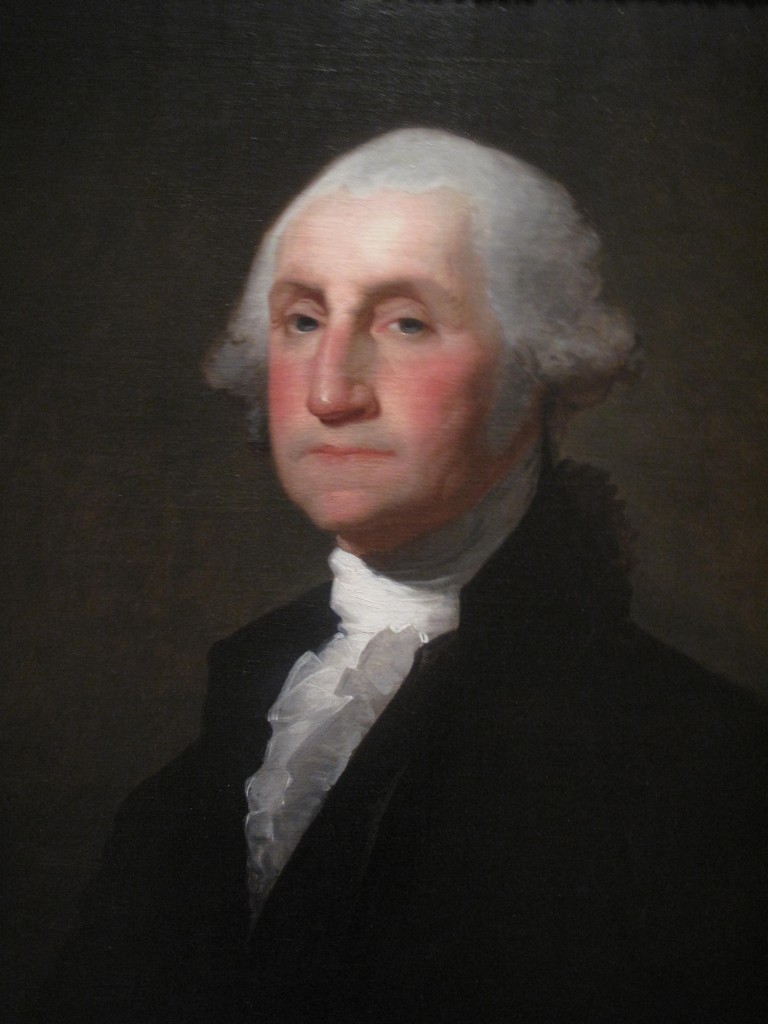
The national capital of the United States is not only the citadel of governance for the world’s most powerful democracy, it is also the repository for an incredible diversity of treasures of art, science, culture, and history. The city itself was designed as a jewel of urban expression by the famed architect Pierre L’Enfant, presented in 1792 as an ideal of a world class city laid out on a marshy elevation north and east of the Potomac River,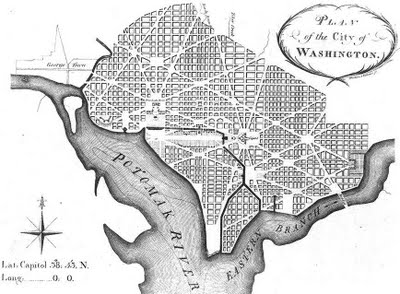 at a time when most of the country’s population was hundreds of miles away from the District of Columbia’s wilderness. French born, L’Enfant was every bit a revolutionary American, who had served as an engineer under Washington, was wounded in the war, suffered with him and the troops at Valley Forge, and later was present for the general’s ultimate victory over Cornwallis. He saw the fledgling nation as a eventual world power and saw no fantasy in designing a world power’s capital stage, with massive boulevards, epic public buildings, and beautiful gardens and squares. The capital he left us is every bit the work of art, and on its grounds contains treasures of incalculable value and diversity.
at a time when most of the country’s population was hundreds of miles away from the District of Columbia’s wilderness. French born, L’Enfant was every bit a revolutionary American, who had served as an engineer under Washington, was wounded in the war, suffered with him and the troops at Valley Forge, and later was present for the general’s ultimate victory over Cornwallis. He saw the fledgling nation as a eventual world power and saw no fantasy in designing a world power’s capital stage, with massive boulevards, epic public buildings, and beautiful gardens and squares. The capital he left us is every bit the work of art, and on its grounds contains treasures of incalculable value and diversity.
Prominent on the National Mall are its magnificent art museums, among so many I would humbly like to highlight two great art repositories, the National Gallery of Art and the Corcoran Gallery. The Corcoran Gallery sits at the west end of the mall juxtaposed to the White House grounds and contains a spectacular display of great American artists of the country’s expansive beginnings. The great portrait artist of the revolutionary period, Gilbert Stuart, is best known for capturing the strength and humanity of our 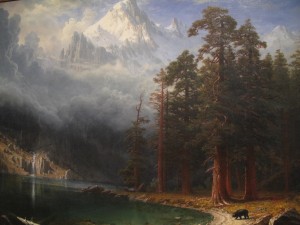 nation’s fathers, no more prominently displayed then in the wonderful Washington portrait of the president seen above. Excellent representations of the American wilderness glorifying American exceptionalism with religious overtones, as a chosen land, abound the walls in great works by Albert Bierstadt and Frederic Edwin Church. Bierstadt’s Corcoran Peak reminde
nation’s fathers, no more prominently displayed then in the wonderful Washington portrait of the president seen above. Excellent representations of the American wilderness glorifying American exceptionalism with religious overtones, as a chosen land, abound the walls in great works by Albert Bierstadt and Frederic Edwin Church. Bierstadt’s Corcoran Peak reminde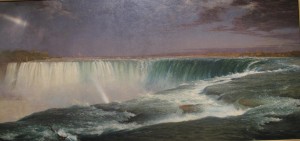 d Americans that the Rockies were every bit as epic as the Alps. Church’s Niagara captured the epic scope of the great falls and reflected the pristine beauty and power of the American wilderness as representative of the country’s power and inexorable drive. The ultimate in scale, imagery, and symbolism of America’s special connection with its pristine, savage wilderness is Bierstadt’s Last of the Buffalo, an homage to a disappearing innocence when the horizon, and the bounty was limitless.
d Americans that the Rockies were every bit as epic as the Alps. Church’s Niagara captured the epic scope of the great falls and reflected the pristine beauty and power of the American wilderness as representative of the country’s power and inexorable drive. The ultimate in scale, imagery, and symbolism of America’s special connection with its pristine, savage wilderness is Bierstadt’s Last of the Buffalo, an homage to a disappearing innocence when the horizon, and the bounty was limitless.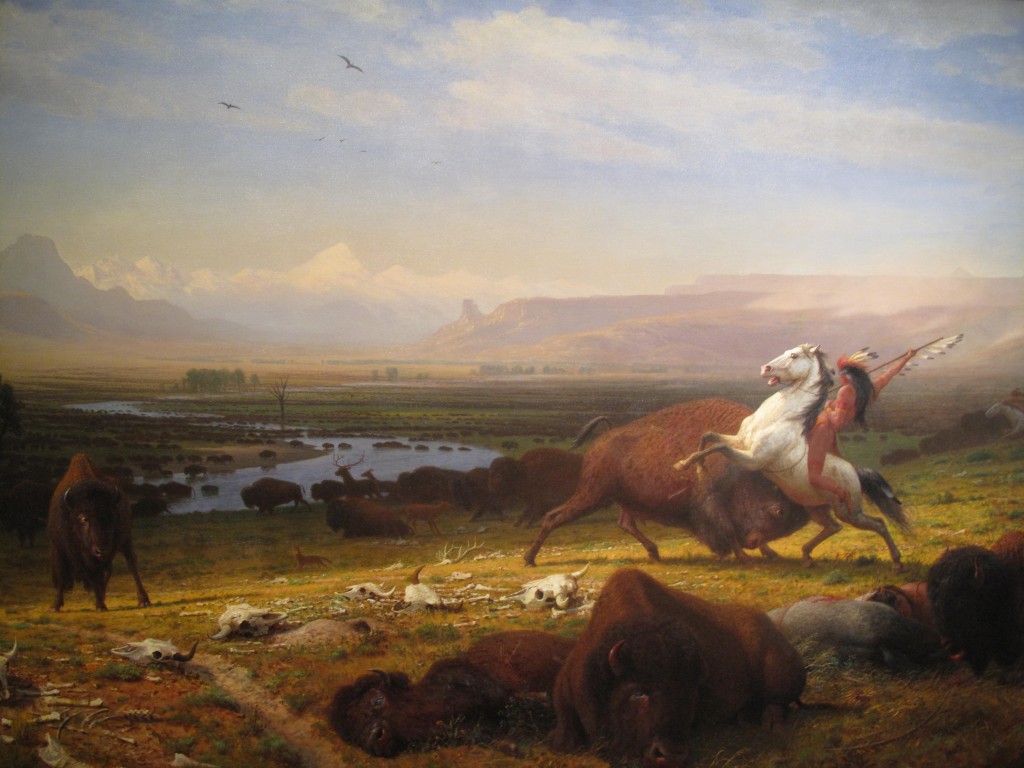 The Corcoran collection extends into other great examples of American painting genius such as Singer Sargent, Mary Cassatt, and Whistler, but does not neglect European masters such as Gainsborough and Rembrandt. It would be the premier display of artistic greatness were it not for the overwhelming spectacle of the collection on the opposite end of the Mall, the National Gallery of Art.
The Corcoran collection extends into other great examples of American painting genius such as Singer Sargent, Mary Cassatt, and Whistler, but does not neglect European masters such as Gainsborough and Rembrandt. It would be the premier display of artistic greatness were it not for the overwhelming spectacle of the collection on the opposite end of the Mall, the National Gallery of Art.
The National Gallery of Art defies a proper adjective for its bounty in fantastic art. Thousands of absolute masterpieces line the walls from the brilliance of American Winslow Homer to three exquisite Vermeers. The very majesty of the collection may be in 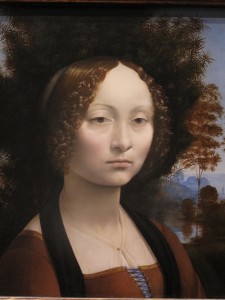 the Mellon family’s greatest gift to the nation, Leonardo DaVinci’s Ginevra de Benci , a painting in my mind every bit as special and beautiful as the Mona Lisa herself. The National Gallery had in 1995 maybe the most spectacularly popular art exhibition in history in providing in one place the entire collected works of Johannes Vermeer, and the representations present currently of this enigmatic Dutch master are worth an hour alone of contemplation. The play of light in its
the Mellon family’s greatest gift to the nation, Leonardo DaVinci’s Ginevra de Benci , a painting in my mind every bit as special and beautiful as the Mona Lisa herself. The National Gallery had in 1995 maybe the most spectacularly popular art exhibition in history in providing in one place the entire collected works of Johannes Vermeer, and the representations present currently of this enigmatic Dutch master are worth an hour alone of contemplation. The play of light in its 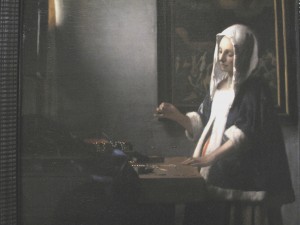 complexity on the every day female subject exemplified in Vermeer’s classic, A Woman Holding a Balance, knows no equal in art. The Americans are also spectacularly represented with the early portraitists such as Copley and Stuart, the chroniclers of American life like Caleb Bingham and James Whistler, and bookended by the brilliant 19th and early 20th century work of Winslow Homer and John Singer Sargent. Homer’s Breezing Up displays common American courage and fortitude in the everyday lives of Americans against the violent environment of the sea.
complexity on the every day female subject exemplified in Vermeer’s classic, A Woman Holding a Balance, knows no equal in art. The Americans are also spectacularly represented with the early portraitists such as Copley and Stuart, the chroniclers of American life like Caleb Bingham and James Whistler, and bookended by the brilliant 19th and early 20th century work of Winslow Homer and John Singer Sargent. Homer’s Breezing Up displays common American courage and fortitude in the everyday lives of Americans against the violent environment of the sea.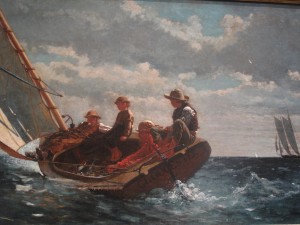 Homer framed America in quiet dignity overwhelmingly influenced by his absorption of the selfless examples of everyday Americans caught up in the brutality of the Civil War yet able to rise above it, and it showed in every subsequent painting. Singer Sargent was a modern painter caught in a 19th century traditionalism that eventually exploded out of his portrait work into emotionally tense works such as Street in Venice where a
Homer framed America in quiet dignity overwhelmingly influenced by his absorption of the selfless examples of everyday Americans caught up in the brutality of the Civil War yet able to rise above it, and it showed in every subsequent painting. Singer Sargent was a modern painter caught in a 19th century traditionalism that eventually exploded out of his portrait work into emotionally tense works such as Street in Venice where a 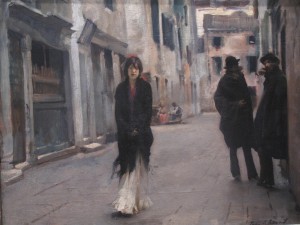 young woman catches the not so innocent stares of young men with a latent sexuality more appropriate for the 20th century than the Victorian principles ruling the nineteenth. Singer Sargent dissolves the puritan impulse forever in the
young woman catches the not so innocent stares of young men with a latent sexuality more appropriate for the 20th century than the Victorian principles ruling the nineteenth. Singer Sargent dissolves the puritan impulse forever in the 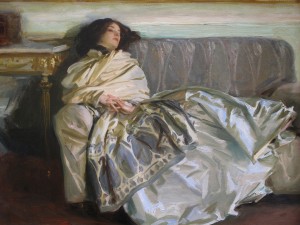 languid Repose, the subject cascading over the boudoir couch in satin finery, her mind distant to the presence of the artist studying her.
languid Repose, the subject cascading over the boudoir couch in satin finery, her mind distant to the presence of the artist studying her.
The bounty that is the National Gallery continues over six centuries of European and American art, from Giotto to Gauguin , Raphael to Rembrandt. Though absorbed for hours over each visage like a boy in the candy shop unable to choose, I still managed to focus on a few artists I have been anxious to see in person. One in particular that brought particular pleasure was J.M.W. Turner, the well known 19th century English painter with extraordinary gifts. An artist who grew out of the romantic stylings of Byron and Beethoven to presage the luminescence and abstraction of Impressionism, Turner imparts a special emotional longing from the viewer. In Keelmen Heaving In Coals By Moonlight, an intense impressionistic lightshow is brought to bear with the furious red glow of the coals juxtaposed on the pewter metallic moonlight, and ghostly ships appearing and disappearing out of the mist. Fantastic.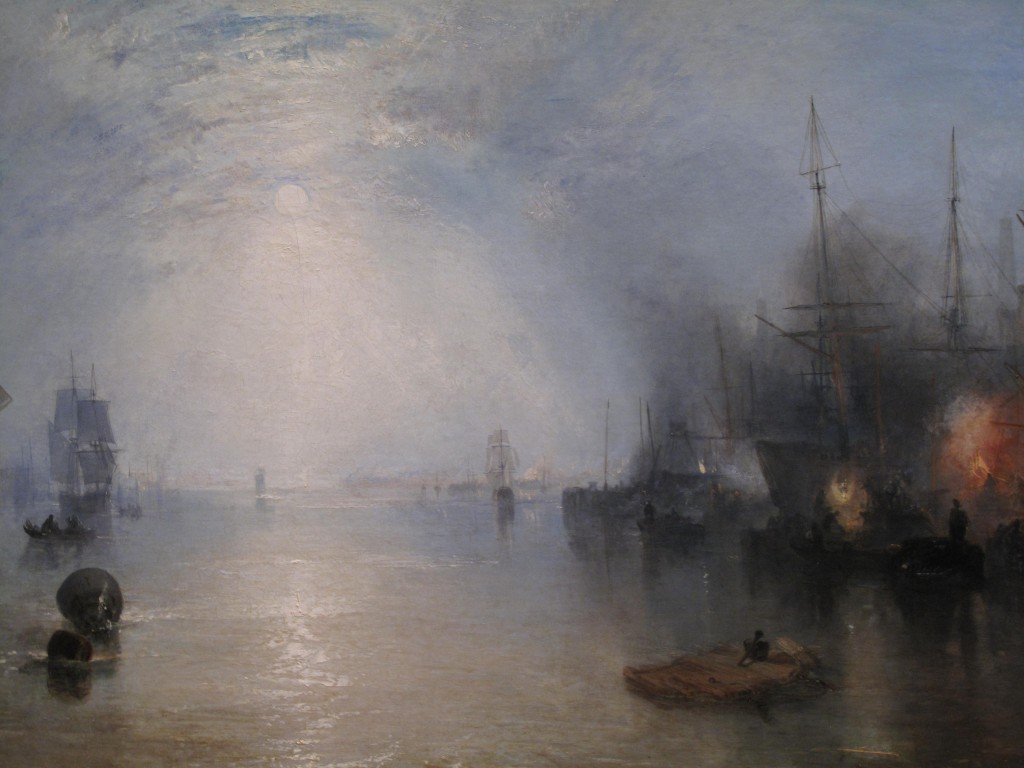 The art alone would take a lifetime to see and absorb it all, but the Smithsonian collection along the Mall is of equal import and diversity in treasure. From Natural History to American History, the Museum of the American Indian, Arts and Industries, and the Portrait Gallery, the Smithsonian spans the American experience. The visual highlight for me on this trip is the Smithsonian Air and Space Museum. The entry alone, contains three epic giants in the history of flight – the Wright Brothers Flyer,
The art alone would take a lifetime to see and absorb it all, but the Smithsonian collection along the Mall is of equal import and diversity in treasure. From Natural History to American History, the Museum of the American Indian, Arts and Industries, and the Portrait Gallery, the Smithsonian spans the American experience. The visual highlight for me on this trip is the Smithsonian Air and Space Museum. The entry alone, contains three epic giants in the history of flight – the Wright Brothers Flyer, 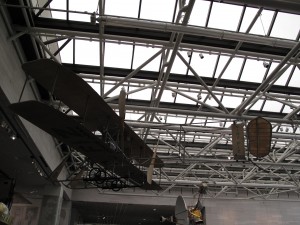 the Spirit of St Louis, and Apollo 11 – from the first controlled flight to man’s conquering of the ocean by air, forever shrinking the planet, to escaping
the Spirit of St Louis, and Apollo 11 – from the first controlled flight to man’s conquering of the ocean by air, forever shrinking the planet, to escaping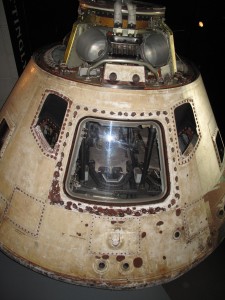 earth to land on another celestial globe. All in the same room and all within 66 years. For whatever reason, I feel the most connectiveness with the little monoplane that carried Charles Lindbergh across the Atlantic in 1927. This was no decade long monumental commitment of a nation to achieve a goal. This was a 24 year old postal service pilot, who rigged a design out of a small American entrepreneurial aircraft company, had them build the craft over a few months, flight tested it by flying it cross country to break the record at that time for solo transcontinental flight, and on the same mission hopped over the Atlantic in 33 consecutive solo flight hours with no backup, no escape plan, and no previous indication of success for such an undertaking. This spectacular little plane would go on to achieve thousands of hours of flight, but the first one is seared in our memory, and our national mythology.
earth to land on another celestial globe. All in the same room and all within 66 years. For whatever reason, I feel the most connectiveness with the little monoplane that carried Charles Lindbergh across the Atlantic in 1927. This was no decade long monumental commitment of a nation to achieve a goal. This was a 24 year old postal service pilot, who rigged a design out of a small American entrepreneurial aircraft company, had them build the craft over a few months, flight tested it by flying it cross country to break the record at that time for solo transcontinental flight, and on the same mission hopped over the Atlantic in 33 consecutive solo flight hours with no backup, no escape plan, and no previous indication of success for such an undertaking. This spectacular little plane would go on to achieve thousands of hours of flight, but the first one is seared in our memory, and our national mythology.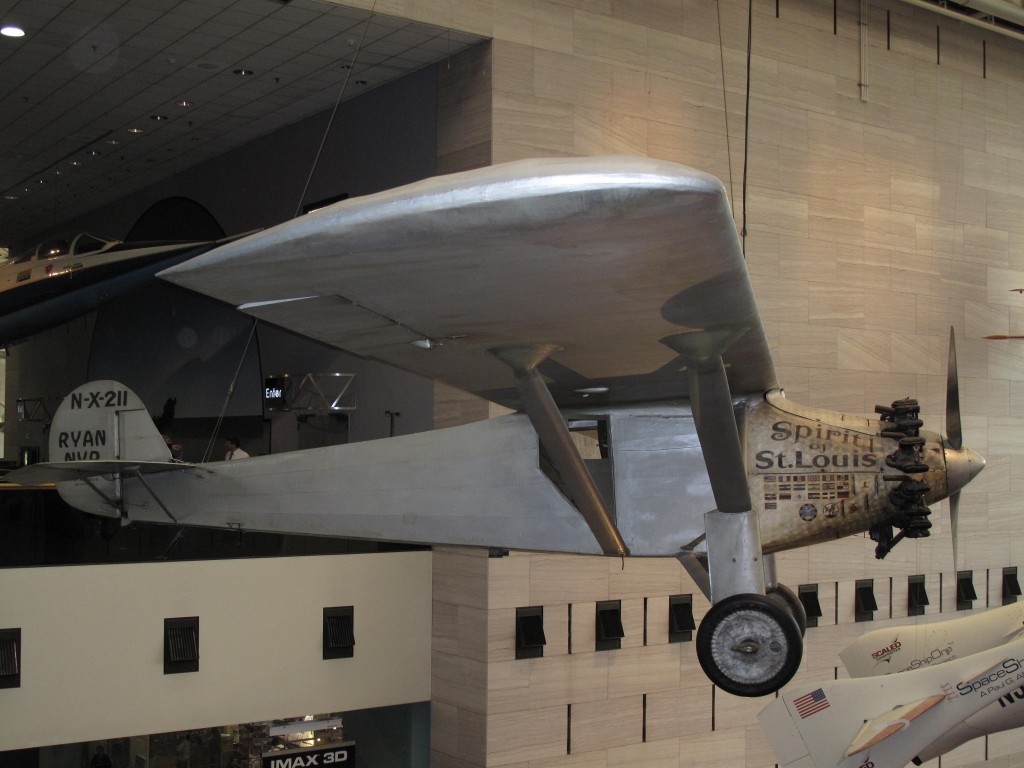 The museum has superb examples of passenger service flight, from the original passenger carrier the Ford Tri-motor to the workhorse of the mid-century the DC-3
The museum has superb examples of passenger service flight, from the original passenger carrier the Ford Tri-motor to the workhorse of the mid-century the DC-3 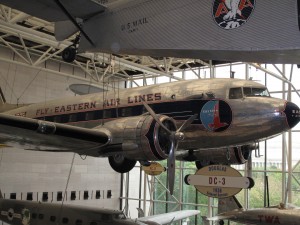 to the modern Boeing 747. It shows in close up fashion the story of combat craft from the Sopwith Camel of World War I to the German Messerschmidts, Japanese Zeroes and American P-51 Mustangs
to the modern Boeing 747. It shows in close up fashion the story of combat craft from the Sopwith Camel of World War I to the German Messerschmidts, Japanese Zeroes and American P-51 Mustangs 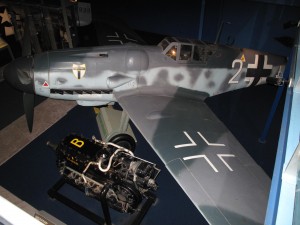 of the Second. The history of rocketry is noted with Minuteman missiles and V-2 rockets, as well as the critical contribution of Russian aerospace from Sputnik to Soyuz.
of the Second. The history of rocketry is noted with Minuteman missiles and V-2 rockets, as well as the critical contribution of Russian aerospace from Sputnik to Soyuz. 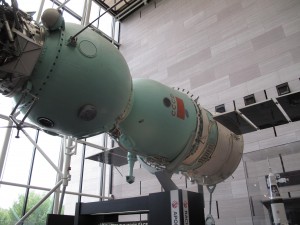 The journey is endless from Tomahawk cruise missiles to Saturn V engines, LEM lunar landers to Space Ship One, the first private service passenger ship to space. Its a visual feast for the air afffectionato and the perfect bookend to the museum extravaganza on the National Mall.
The journey is endless from Tomahawk cruise missiles to Saturn V engines, LEM lunar landers to Space Ship One, the first private service passenger ship to space. Its a visual feast for the air afffectionato and the perfect bookend to the museum extravaganza on the National Mall.
This brief survey does not scratch remotely all that there is to explore in the national repositories celebrating our civilization’s watershed achievements. each venue offers days of study and a lifetime of reading. Consider the story of the electric light bulb or the electric guitar, the harvesting of hydroelectric power, the prayers of the Navajo, the invention and outgrowth of the gasoline engine, the crafts of the native Americans and those who suffered in servitude, the portraits of all the nation’s chief executives, the dresses of the First Ladies. On and on and on in magnificent promotion of what it means to struggle, to seek, to conquer, to create, and ultimately to triumph in the never ending celebration of life well lived.